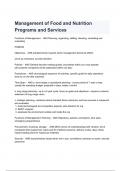Management of Food and Nutrition
Programs and Services
Functions of Management - ANS Planning, organizing, staffing, directing, controlling and
evaluating
POSDCE
Objectives - ANS predetermined; towards which management directs its efforts
serve as motivators, provide direction
Policies - ANS General decision-making guides, boundaries within you must operate
(all customer complaints will be addressed within one day)
Procedures - ANS chronological sequence of activities, specific guide for daily operations
(how to run the dish machine)
Time Span - ANS a. short range or operational planning - covers period of 1 year or less;
usually the operating budget; projected in days, weeks, months
b. long range planning - up to a 5 year cycle, focus on goals and objectives - requires a mission
statement of long range vision
c. strategic planning - decisions about intended future outcomes, and how success is measured
and evaluated
1. broad technological and competitive aspects; sets direction for org
2. SWOT analysis
3. assesses the environment outside and inside the org
Functions of Management: Planning - ANS Objectives, policies, procedures, time span,
emergency preparedness
Procurement, receiving, storage: - ANS MOU (memo of understanding) with vendors, list of
companies that supply food, name and ID of delivery persons; delivery routes, days, times;
inspect loading dock for suspicious materials
Security - ANS doors/windows locked when not in use, surveillance cameras on docks, security
personnel
,Production and service: - ANS safe food practices followed, issued foods checked, hands
washed, authorized personnel prepare and serve food
Functions of Management: Organizing and Staffing - Functions - ANS a. identify tasks and
activities, divide tasks into positions
b. establish relationships among all other functions of management
Functions of Management: Organizing and Staffing -
Organizational Structure - ANS a. Organizational chart - shows how the employee fits into the
organization
1. shows relationship of positions and functions
2. depicts lines of authority shown with solid lines (chain of command)
3. advisory (staff) positions shown with dotted lines
4. not shown: :degree of authority at each level, informal relationships
b. chain of command - shows command relationship from top to lowest level
1. begins with one person and extends downward
c. staff - advisory, specialists
1. advise and support the line, but not involved in day to day operations
2. Personnel Director, Consultant Dietitian in a nursing home
d. functional - serves as both line and staff
1. has limited authority over a segment of activity because of specialized knowledge, units are
defined by the nature of the work. The responsibility of purchasing may be given to a head
purchasing agent who oversees that function in all departments. Efficient use of resources.
e. span of control - number of individuals or departments under the direction of one individual
***1. narrow span - more levels are created; need more managers; needed with newly hired
personnel
2. wide span - fewer levels and fewer managers are needed, used with highly trained, highly
motivated workers
Functions of Management: Organizing and Staffing -
Determining Staffing Needs - ANS a. staffing patterns
***1. acute care conventional: 17 min per meal or 3.5 meals per labor hour
2. extended care facilities: 5 meals/labor hour
3. cafeteria: 5.5 meals/labor hour
***4. school foodservice: 13-15 meals/labor hour
5. these reflect averages and are only used as guides
6. when determining meals served, consider meal equivalents
If it takes as much labor to produce 6 nourishments as it does 1 meal, then 6 nourishments are
equivalent in labor to 1 meal
, 7. meal equivalent is a measure of productivity defined as the amount of all food sales divided
by the average cost of a typical (prototype) meal
b. work schedules usually include an 8 hour work day, a 30 minute lunch break and one or two
15 minute work breaks
1. master - serves as overall plan; days on and off; vacations; basis for developing weekly
schedules
2. shift - staffing patterns for a particular operation; positions and hours worked, numbers of
days worked per week, relief assignments
3. production schedule - time sequencing of events required to produce a meal; employee
assignments and menu items; quantity to prepare and the timing (what to do when)
c. FTE - full time equivalent
1. absolute FTE - minimum number of employees needed to staff the facility; counts productive
hours (hours actually worked)
2. adjusted FTE also takes into account the benefit days and days off (includes PTO)
3. compute by dividing the total number of hours used in operating the foodservice for a period
of time by the normal workload hours of one employee
Mgmt Function: Organizing and Staffing continued - ANS d. relief workers
1. approximately 1.55 employees are necessary for everyday coverage of full time positions.
Full time employees generally are available an average of only 236 days per year because of
days off and benefit days (129 days)
2. To determine the actual number of employees needed, multiply the number of full time
positions by 0.55 (129/236) to get the number of relief workers needed to cover 365 days per
year.
3. Hospital food service positions cover 7 days a week. Employees work 5 days and have 2 off.
A relief worker covers those 2 days off and can also work a 5 day week. So a relief worker can
cover the "days off" of 2.5 full time workers each week. 5/2 = 2.5
4. Work simplification procedures
a. features
1. purpose: eliminate unnecessary parts of job and those that add no value
2. looks at smallest parts of the job (hand movements, steps taken)
3. increases productivity and decreases costs
b. examples of work simplification procedures
1. motion economy - reduce motions and time required - uses shortest and straightest routes to
move materials. Movement should be: simultaneous, symmetrical, natural, rhythmic, habitual




